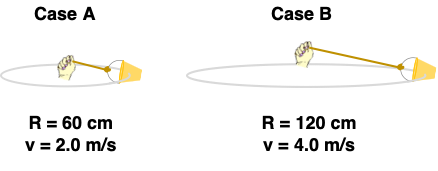The angular velocity refers rate at which an point rotates about the axis of rotation. It is typically expressed in radians/second, revolutions/minute (rpm), or degrees/second. The angular velocity can be related to the linear velocity and the distance the point is from the axis of rotation. See How to Think About This Situation for more details.
Hold down the T key for 3 seconds to activate the audio accessibility mode, at which point you can click the K key to pause and resume audio. Useful for the Check Your Understanding and See Answers.
Linear and Angular Velocity - help9
There are four similar versions of this question. Here is one of the versions:
Version 1:
In the World Peace Lab, a bucket filled with peas is whirled in a horizontal circle with varying radii and linear velocities. The circle radius (R) and linear velocity (v) for Case A and Case B are shown. How does the angular velocity of the two buckets compare to one another?

The angular velocity in Case A is ______ the angular velocity in Case B.
the same as
two times greater than
four times greater than
two times less than
four times less than
Try these links to The Physics Classroom Tutorial for more help with understanding the concept of angular position and displacement:
Sorry. We hope to add resources in the future.